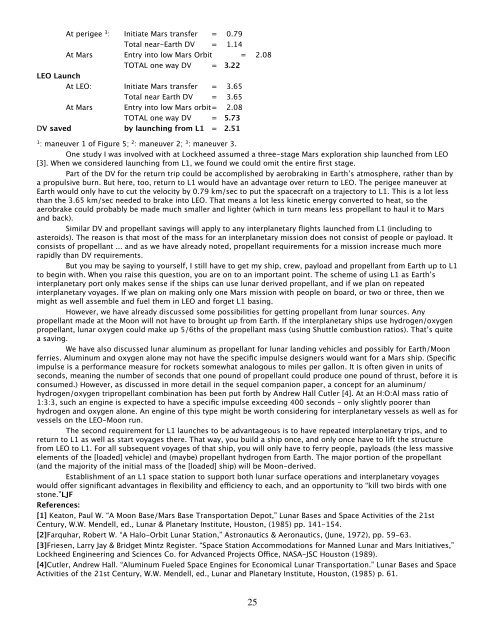Space Transportation - mmmt_transportation.pdf - Moon Society
Space Transportation - mmmt_transportation.pdf - Moon Society
Space Transportation - mmmt_transportation.pdf - Moon Society
Create successful ePaper yourself
Turn your PDF publications into a flip-book with our unique Google optimized e-Paper software.
At perigee 3 : Initiate Mars transfer = 0.79<br />
Total near-Earth DV = 1.14<br />
At Mars Entry into low Mars Orbit = 2.08<br />
TOTAL one way DV = 3.22<br />
LEO Launch<br />
At LEO: Initiate Mars transfer = 3.65<br />
Total near Earth DV = 3.65<br />
At Mars Entry into low Mars orbit= 2.08<br />
TOTAL one way DV = 5.73<br />
DV saved by launching from L1 = 2.51<br />
1 : maneuver 1 of Figure 5; 2 : maneuver 2; 3 : maneuver 3.<br />
One study I was involved with at Lockheed assumed a three-stage Mars exploration ship launched from LEO<br />
[3]. When we considered launching from L1, we found we could omit the entire first stage.<br />
Part of the DV for the return trip could be accomplished by aerobraking in Earth’s atmosphere, rather than by<br />
a propulsive burn. But here, too, return to L1 would have an advantage over return to LEO. The perigee maneuver at<br />
Earth would only have to cut the velocity by 0.79 km/sec to put the spacecraft on a trajectory to L1. This is a lot less<br />
than the 3.65 km/sec needed to brake into LEO. That means a lot less kinetic energy converted to heat, so the<br />
aerobrake could probably be made much smaller and lighter (which in turn means less propellant to haul it to Mars<br />
and back).<br />
Similar DV and propellant savings will apply to any interplanetary flights launched from L1 (including to<br />
asteroids). The reason is that most of the mass for an interplanetary mission does not consist of people or payload. It<br />
consists of propellant ... and as we have already noted, propellant requirements for a mission increase much more<br />
rapidly than DV requirements.<br />
But you may be saying to yourself, I still have to get my ship, crew, payload and propellant from Earth up to L1<br />
to begin with. When you raise this question, you are on to an important point. The scheme of using L1 as Earth’s<br />
interplanetary port only makes sense if the ships can use lunar derived propellant, and if we plan on repeated<br />
interplanetary voyages. If we plan on making only one Mars mission with people on board, or two or three, then we<br />
might as well assemble and fuel them in LEO and forget L1 basing.<br />
However, we have already discussed some possibilities for getting propellant from lunar sources. Any<br />
propellant made at the <strong>Moon</strong> will not have to brought up from Earth. If the interplanetary ships use hydrogen/oxygen<br />
propellant, lunar oxygen could make up 5/6ths of the propellant mass (using Shuttle combustion ratios). That’s quite<br />
a saving.<br />
We have also discussed lunar aluminum as propellant for lunar landing vehicles and possibly for Earth/<strong>Moon</strong><br />
ferries. Aluminum and oxygen alone may not have the specific impulse designers would want for a Mars ship. (Specific<br />
impulse is a performance measure for rockets somewhat analogous to miles per gallon. It is often given in units of<br />
seconds, meaning the number of seconds that one pound of propellant could produce one pound of thrust, before it is<br />
consumed.) However, as discussed in more detail in the sequel companion paper, a concept for an aluminum/<br />
hydrogen/oxygen tripropellant combination has been put forth by Andrew Hall Cutler [4]. At an H:O:Al mass ratio of<br />
1:3:3, such an engine is expected to have a specific impulse exceeding 400 seconds - only slightly poorer than<br />
hydrogen and oxygen alone. An engine of this type might be worth considering for interplanetary vessels as well as for<br />
vessels on the LEO-<strong>Moon</strong> run.<br />
The second requirement for L1 launches to be advantageous is to have repeated interplanetary trips, and to<br />
return to L1 as well as start voyages there. That way, you build a ship once, and only once have to lift the structure<br />
from LEO to L1. For all subsequent voyages of that ship, you will only have to ferry people, payloads (the less massive<br />
elements of the [loaded] vehicle) and (maybe) propellant hydrogen from Earth. The major portion of the propellant<br />
(and the majority of the initial mass of the [loaded] ship) will be <strong>Moon</strong>-derived.<br />
Establishment of an L1 space station to support both lunar surface operations and interplanetary voyages<br />
would offer significant advantages in flexibility and efficiency to each, and an opportunity to “kill two birds with one<br />
stone.”LJF<br />
References:<br />
[1] Keaton, Paul W. “A <strong>Moon</strong> Base/Mars Base <strong>Transportation</strong> Depot,” Lunar Bases and <strong>Space</strong> Activities of the 21st<br />
Century, W.W. Mendell, ed., Lunar & Planetary Institute, Houston, (1985) pp. 141-154.<br />
[2]Farquhar, Robert W. “A Halo-Orbit Lunar Station,” Astronautics & Aeronautics, (June, 1972), pp. 59-63.<br />
[3]Friesen, Larry Jay & Bridget Mintz Register. “<strong>Space</strong> Station Accommodations for Manned Lunar and Mars Initiatives,”<br />
Lockheed Engineering and Sciences Co. for Advanced Projects Office, NASA-JSC Houston (1989).<br />
[4]Cutler, Andrew Hall. “Aluminum Fueled <strong>Space</strong> Engines for Economical Lunar <strong>Transportation</strong>.” Lunar Bases and <strong>Space</strong><br />
Activities of the 21st Century, W.W. Mendell, ed., Lunar and Planetary Institute, Houston, (1985) p. 61.<br />
25















